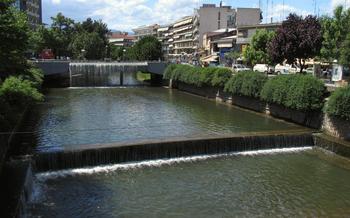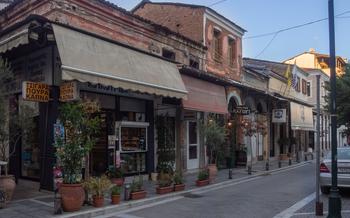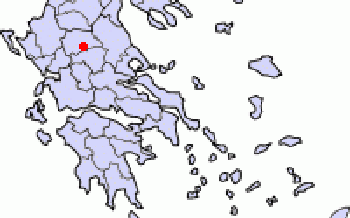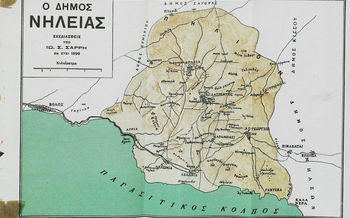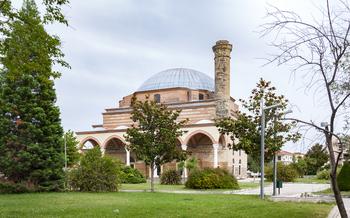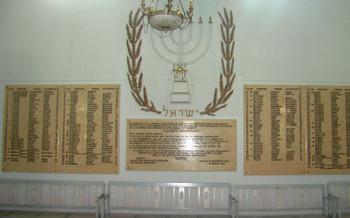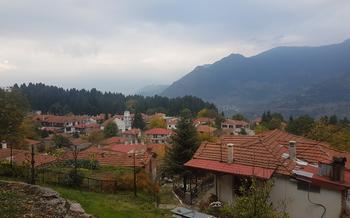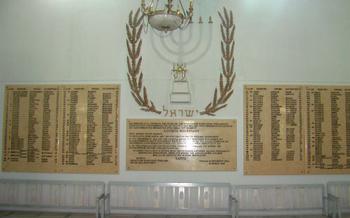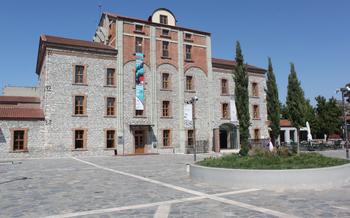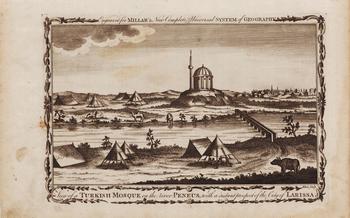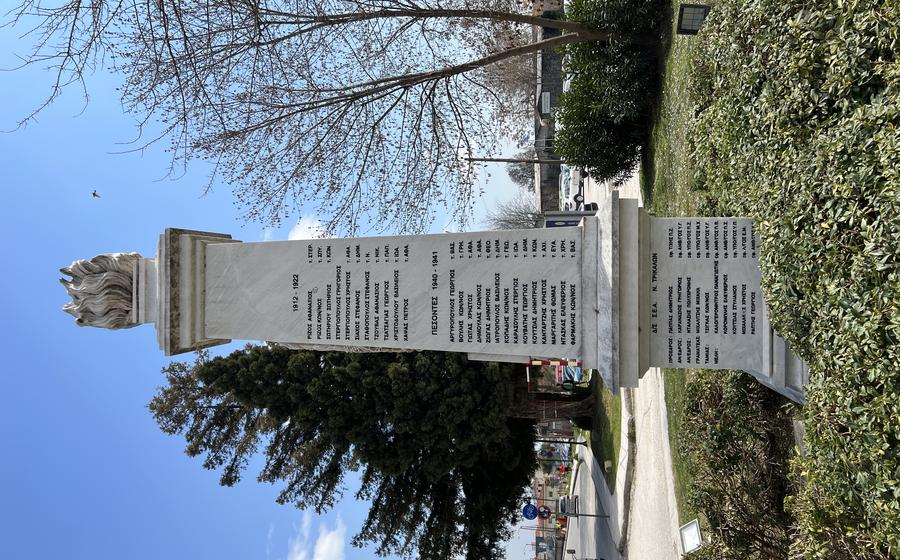
Neolithic Settlement of Megalo Kefalovriso
- The Neolithic Settlement of Megalo Kefalovriso:
- A Journey Through Time:
- The Excavation Process:
- The Settlement's Layout
- The People of Megalo Kefalovriso
- Unveiling the Artifacts
- Religious Beliefs and Rituals
- Trade and Cultural Exchange:
- The End of an Era
- The Museum of Megalo Kefalovriso: Delving into the Past
- Tips for Visitors
- Local Cuisine
- Nearby Attractions
- Accommodation Options:
- Insider Tip: Unveiling Hidden Gems
The Neolithic Settlement of Megalo Kefalovriso:
In the heart of Thessaly, Greece, lies the Neolithic settlement of Megalo Kefalovriso, a testament to the ingenuity and craftsmanship of our ancestors. This remarkably preserved village, dating back to 6500 BC, offers a glimpse into the lives of the earliest farmers and herders who laid the foundation for modern civilization.
Location and Accessibility: Megalo Kefalovriso is situated near the village of Palaiokastro, just a short drive from the city of Trikala. Its strategic location on a hilltop overlooking the Thessalian plain made it an ideal spot for settlement, providing both security and access to fertile land.
Importance of the Archaeological Findings: The excavation of Megalo Kefalovriso has yielded a treasure trove of artifacts, including tools, weapons, pottery, and jewelry, providing valuable insights into the daily lives, social structure, and technological advancements of the Neolithic period. The well-preserved architecture and layout of the settlement have further contributed to our understanding of this pivotal era in human history.
Visiting Hours and Ticket Prices: The Neolithic settlement of Megalo Kefalovriso is open to the public, offering visitors an immersive journey into the past. Visiting hours typically run from 8:30 am to 3:00 pm, and admission tickets are affordably priced, making it an accessible destination for history enthusiasts and curious travelers alike.
A Journey Through Time:
The Neolithic Settlement of Megalo Kefalovriso offers a unique glimpse into the lives of our ancestors who lived in this region over 7,000 years ago. As you explore the site, you'll be transported back in time to an era when humans were just beginning to transition from a nomadic lifestyle to a more settled existence. The Neolithic period, which lasted from approximately 10,000 to 3,000 BC, marked a significant turning point in human history, and Megalo Kefalovriso provides a tangible connection to this transformative era.
Here, you can gain insights into the daily lives, customs, and beliefs of the Neolithic people. The well-preserved remains of their homes, workshops, and public spaces offer a glimpse into their social organization, economic activities, and technological advancements. The settlement also reveals their artistic expressions, religious practices, and trading networks, providing a comprehensive understanding of their culture.
As you wander through the site, imagine the hustle and bustle of a thriving Neolithic community. Picture the inhabitants going about their daily routines, crafting tools, cooking meals, trading goods, and engaging in rituals. The Neolithic era was a time of great innovation and adaptation, and Megalo Kefalovriso showcases the ingenuity and resilience of our ancestors as they embraced a new way of life.
The Excavation Process:
The excavation of the Neolithic Settlement of Megalo Kefalovriso was a meticulous and challenging endeavor. Archaeologists faced several obstacles, including the preservation of fragile artifacts, battling harsh weather conditions, and ensuring the safety of the site.
Excavations began in the 1960s, uncovering the well-preserved remains of Neolithic houses, workshops, and public spaces. The site's excellent condition allowed archaeologists to gain valuable insights into the daily lives and activities of the settlement's inhabitants.
To uncover and document the site's secrets, archaeologists employed a range of techniques. Careful excavation methods were used to expose the structures and artifacts without causing damage. Detailed records were kept, including photographs, drawings, and notes, to create a comprehensive record of the site.
Artifacts were meticulously collected and cataloged, providing a wealth of information about the settlement's inhabitants. These artifacts, ranging from tools and weapons to pottery and jewelry, offered clues about their daily lives, economic activities, and cultural practices.
The ongoing work of archaeologists at Megalo Kefalovriso continues to shed light on the Neolithic era. Through their tireless efforts, we gain a deeper understanding of this ancient civilization and its profound impact on the development of Greek history.
The Settlement's Layout
The Neolithic Settlement of Megalo Kefalovriso exhibits distinctive architectural features that provide valuable insights into the lifestyle and social organization of its inhabitants. The houses, typically rectangular in shape, were constructed using local materials such as mudbricks and stone. They featured sturdy foundations, walls reinforced with wooden beams, and thatched roofs. The floors were often covered with a layer of clay or pebbles to provide insulation and protection from moisture.
The settlement was well-organized, with different sections dedicated to specific purposes. Residential areas, where families lived and raised their children, were separated from communal spaces such as workshops and storage facilities. Public spaces, such as plazas or meeting areas, were located at the heart of the settlement and served as gathering places for social and religious activities.
The layout of the settlement reveals evidence of advanced planning and construction techniques. The streets were laid out in a grid-like pattern, ensuring efficient movement and access to different parts of the settlement. The houses were arranged in rows, creating a sense of order and uniformity. This organized layout suggests that the Neolithic people possessed considerable knowledge of urban planning and architecture.
The People of Megalo Kefalovriso
The inhabitants of the Neolithic settlement of Megalo Kefalovriso led a life deeply rooted in the rhythms of nature and community. Their daily routine revolved around subsistence activities such as farming, hunting, and gathering. The community worked together to ensure the survival and prosperity of the settlement. Evidence suggests that they practiced a form of agriculture, cultivating crops like wheat and barley, and raising livestock such as sheep, goats, and cattle. Hunting and gathering supplemented their diet, providing them with a diverse range of food sources. Within the settlement, social roles were likely defined by age, gender, and skills. Elders and experienced individuals held positions of respect and authority. The community's social structure was based on cooperation and interdependence, with everyone contributing to the well-being of the group. By studying the artifacts and remains found at the site, archaeologists have been able to piece together a vivid picture of the daily lives and social interactions of the Neolithic people of Megalo Kefalovriso.
Unveiling the Artifacts
The excavation of Megalo Kefalovriso has yielded a wealth of artifacts that provide invaluable insights into the lives and culture of its Neolithic inhabitants. These artifacts, ranging from tools and weapons to household items, pottery, jewelry, and decorative objects, offer a tangible glimpse into their daily routines, economic activities, and artistic expressions.
Tools made of stone, bone, and antler, such as axes, scrapers, and arrowheads, reveal the settlement's technological capabilities and subsistence strategies. Weapons, including spearheads and daggers, suggest the importance of hunting and self-defense. Household items, such as pottery vessels, grinding stones, and loom weights, provide evidence of domestic activities like cooking, food storage, and textile production.
Pottery, often decorated with intricate patterns and motifs, showcases the artistic skills of the Neolithic people. Jewelry, including beads, pendants, and bracelets, made from materials like bone, shell, and stone, highlights their love of adornment and personal expression. Other decorative objects, such as figurines and carved stones, offer glimpses into their religious beliefs and symbolic practices.
The study of these artifacts has allowed archaeologists to reconstruct the daily lives, economic activities, and cultural practices of the Neolithic people who inhabited Megalo Kefalovriso. They provide a tangible connection to the past, allowing us to understand how these ancient people lived, worked, and interacted with their environment.
Religious Beliefs and Rituals
The Neolithic inhabitants of Megalo Kefalovriso held strong religious beliefs and engaged in various rituals. The settlement's layout and artifacts provide clues about their spiritual practices. Evidence suggests the presence of ritual structures, such as altars or shrines, where ceremonies and offerings may have taken place. Symbolic artifacts like figurines, amulets, and carved stones hint at their beliefs in supernatural powers and deities. These findings offer insights into the spiritual world of the Neolithic people and their connection to broader religious developments in the region.
Trade and Cultural Exchange:
The Neolithic settlement of Megalo Kefalovriso was not an isolated community. Evidence suggests that its inhabitants engaged in trade and cultural exchange with other regions. Imported goods, such as obsidian from the Aegean islands and shells from the Mediterranean Sea, have been discovered at the site. These artifacts indicate that the settlement had connections with distant communities and participated in a broader network of exchange.
The presence of imported goods at Megalo Kefalovriso highlights the interconnectedness of Neolithic societies. Trade played a crucial role in the dissemination of ideas, technologies, and cultural practices across different regions. By exchanging goods and knowledge, the inhabitants of Megalo Kefalovriso were part of a larger cultural tapestry that extended beyond their immediate surroundings.
The settlement's location at a crossroads of trade routes likely contributed to its role as a trading hub. Situated in the Thessalian plain, Megalo Kefalovriso was well-positioned to facilitate the movement of goods and people between different parts of Greece and beyond. This strategic location allowed the settlement to thrive and become a center of cultural exchange and innovation.
The interaction with neighboring communities also influenced the cultural development of Megalo Kefalovriso. The settlement's inhabitants adopted and adapted ideas and practices from other cultures, resulting in a unique blend of local and foreign influences. This cultural exchange contributed to the richness and diversity of Neolithic society at Megalo Kefalovriso.
The End of an Era
The reasons behind the eventual abandonment of the Neolithic settlement of Megalo Kefalovriso remain shrouded in the mists of time. Scholars have advanced various theories to explain this enigma. One prevailing hypothesis centers on climatic changes that may have caused shifts in agricultural patterns and water availability, ultimately rendering the area less conducive to human habitation.
Another theory suggests that the settlement was abandoned due to conflicts or competition with neighboring communities. As other Neolithic settlements emerged and grew in the region, competition for resources and territory may have intensified, leading to tensions and potentially violent clashes.
It is also possible that a combination of factors, including environmental changes and social dynamics, contributed to the settlement's decline. As the Neolithic period drew to a close, new cultural and technological developments were emerging, and the people of Megalo Kefalovriso may have migrated to other regions in search of new opportunities and more favorable conditions.
Despite its eventual abandonment, the legacy of the Neolithic people of Megalo Kefalovriso endured. Their contributions to agriculture, architecture, and social organization laid the foundation for subsequent civilizations in the region. The settlement stands as a testament to the ingenuity, resilience, and creative spirit of these early inhabitants of Greece, whose innovations and achievements continue to inspire and fascinate to this day.
The Museum of Megalo Kefalovriso: Delving into the Past
Just a stone's throw from the Neolithic Settlement of Megalo Kefalovriso, the eponymous museum stands as a testament to the site's profound significance. Within its walls, a treasure trove of artifacts, meticulously excavated and preserved, awaits the curious visitor.
Location and Accessibility:
Situated in the heart of Trikala, the Museum of Megalo Kefalovriso is easily accessible by foot or public transportation. Its prime location ensures that visitors can seamlessly transition from exploring the ancient settlement to immersing themselves in its tangible legacy.
Exhibits and Displays:
As you step into the museum, you are greeted by a captivating array of exhibits that bring the Neolithic era vividly to life. Artifacts, ranging from intricately decorated pottery and tools to awe-inspiring sculptures, are showcased in a manner that invites both fascination and contemplation.
Interactive Exhibits and Educational Programs:
The museum's commitment to engaging visitors extends beyond static displays. Interactive exhibits, designed with both children and adults in mind, provide hands-on experiences that deepen the understanding of Neolithic life. Educational programs, workshops, and guided tours further enrich the visitor experience, offering an immersive journey into the past.
Preserving and Promoting the Site's Heritage:
The Museum of Megalo Kefalovriso plays a pivotal role in preserving and promoting the site's unique heritage. Through its meticulously curated exhibits, educational initiatives, and research endeavors, the museum ensures that the legacy of this remarkable settlement continues to inspire and captivate generations to come.
Tips for Visitors
To make the most of your visit to the Neolithic Settlement of Megalo Kefalovriso, here are some practical tips to consider:
-
Plan your visit during the spring or fall to avoid the summer heat and crowds. The pleasant weather during these seasons allows for a more comfortable exploration of the site.
-
Wear comfortable clothing and sturdy footwear, as the terrain can be uneven and rocky. Closed-toe shoes are recommended for safety and protection.
-
Bring water and snacks with you, as there are limited facilities on-site. Stay hydrated and energized throughout your visit to fully appreciate the historical significance of Megalo Kefalovriso.
-
Be respectful of the site's historical importance. Avoid touching or disturbing any artifacts or structures. Preserve the integrity of the site for future generations to appreciate.
Local Cuisine
Indulge in the culinary delights of Greece while visiting the Neolithic Settlement of Megalo Kefalovriso. The region boasts a vibrant culinary scene with an array of traditional dishes that have been passed down through generations.
For an authentic taste of Greek cuisine, head to "To Steki tou Ilia," a charming tavern located just a short drive from the site. Savor the flavors of mouthwatering souvlaki, grilled to perfection and served with fresh vegetables and tzatziki sauce.
Don't miss out on the opportunity to try "gemista," a traditional Greek dish consisting of tomatoes, peppers, and zucchini stuffed with rice, herbs, and spices, baked to perfection in a rich tomato sauce.
For those who prefer seafood, "To Kyma" restaurant offers a delightful selection of freshly caught fish and seafood delicacies. Indulge in grilled octopus, succulent shrimp, or the catch of the day, prepared with local herbs and olive oil.
Pair your meal with a glass of local wine, such as the renowned Trikala red wine, and experience the perfect harmony of flavors. Whether you choose to dine at a traditional taverna or a modern restaurant, the local cuisine of the region will surely tantalize your taste buds and leave you wanting more.
Nearby Attractions
Beyond the Neolithic Settlement of Megalo Kefalovriso, Trikala offers a wealth of additional attractions. Historical enthusiasts will delight in exploring the Trikala Castle, a 13th-century fortress that stands as a testament to the region's rich past. The Meteora Monasteries, a UNESCO World Heritage Site, are a must-visit for their stunning architecture and breathtaking views.
Nature lovers can indulge in outdoor activities amidst Trikala's scenic landscapes. The Trikala River offers opportunities for kayaking, rafting, and fishing. The Trikala Forest beckons with its hiking trails, mountain biking paths, and picnic spots. For a refreshing escape, head to the Lake Plastira, a picturesque artificial lake surrounded by lush greenery.
Cultural aficionados will find Trikala's museums and art galleries captivating. The Trikala Municipal Art Gallery showcases a diverse collection of paintings, sculptures, and other artworks. The Trikala Archaeological Museum houses a treasure trove of artifacts from the region's ancient past.
Accommodation Options:
When planning your trip to Megalo Kefalovriso, you'll find a range of accommodation options to suit different budgets and preferences. The charming town of Kalambaka, just a short drive away, offers a variety of hotels, guesthouses, and traditional lodgings. For a truly immersive experience, consider staying in a traditional Greek guesthouse or a small family-run hotel. These accommodations often provide a warm and welcoming atmosphere, allowing you to connect with the local culture and enjoy authentic Greek hospitality.
To ensure a comfortable stay, book your accommodation in advance, especially during the peak tourist season from July to September. This will guarantee you a place to rest and recharge after your explorations of the Neolithic settlement and the surrounding area. Whether you prefer modern amenities or a more rustic experience, you'll find suitable options that cater to your needs and make your visit to Megalo Kefalovriso truly memorable.
Insider Tip: Unveiling Hidden Gems
Beyond the main attractions, the region surrounding the Neolithic Settlement of Megalo Kefalovriso holds a treasure trove of hidden gems waiting to be discovered. For those seeking a truly immersive experience, venturing off the beaten path is highly recommended.
One such hidden gem is the picturesque village of Pyli, nestled amidst lush greenery and boasting stunning views of the surrounding mountains. Stroll through its narrow cobblestone streets, admire traditional stone houses adorned with colorful flowers, and savor authentic Greek cuisine at local tavernas.
For nature enthusiasts, the nearby Gorge of Portaikos offers breathtaking scenery and a chance to witness the region's rich biodiversity. Hike along the gorge's winding trails, marvel at towering rock formations, and immerse yourself in the tranquility of nature.
If you're an adrenaline junkie, the mountain village of Elati is a haven for outdoor activities. Embark on thrilling mountain biking trails, test your limits with rock climbing adventures, or glide through the air on a zip line, enjoying panoramic views of the surrounding landscape.
Remember, the true essence of a place often lies in its hidden gems. Embrace the spirit of exploration, engage with the locals, and uncover the secrets that make this region so captivating. Your journey to Megalo Kefalovriso will be enriched by these hidden treasures, leaving you with unforgettable memories and a deeper appreciation for the region's diverse offerings.
